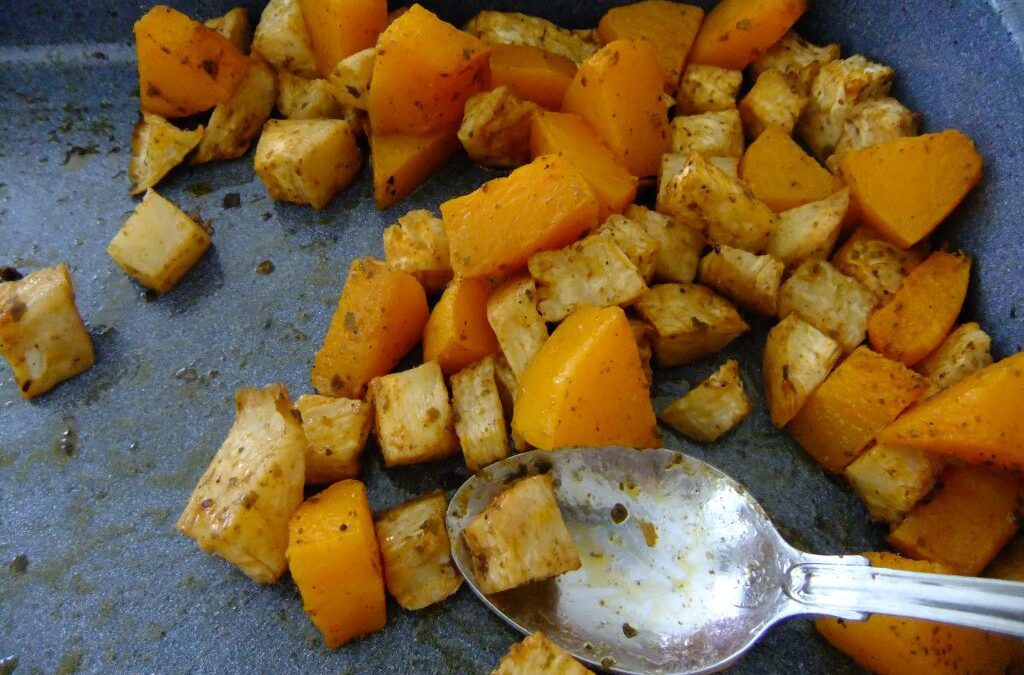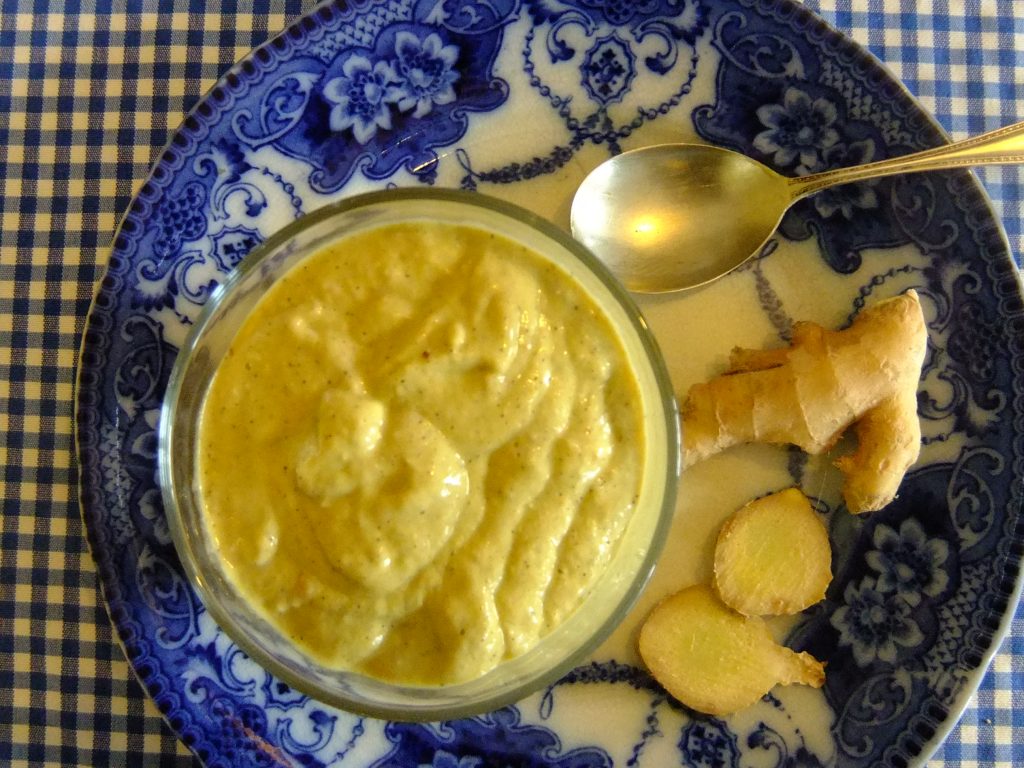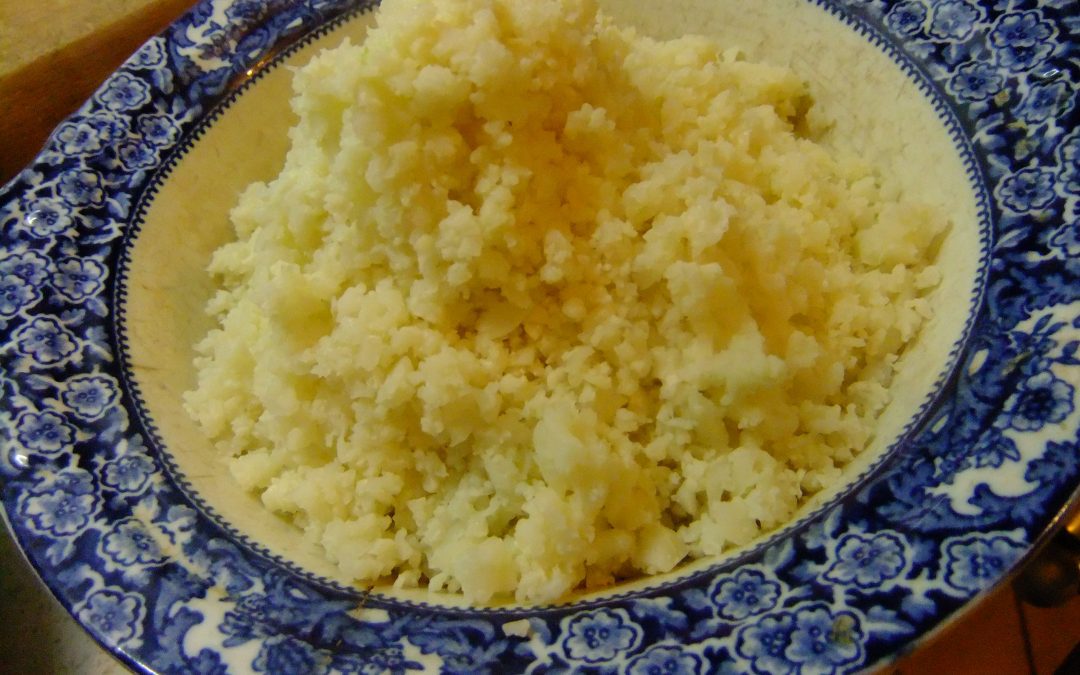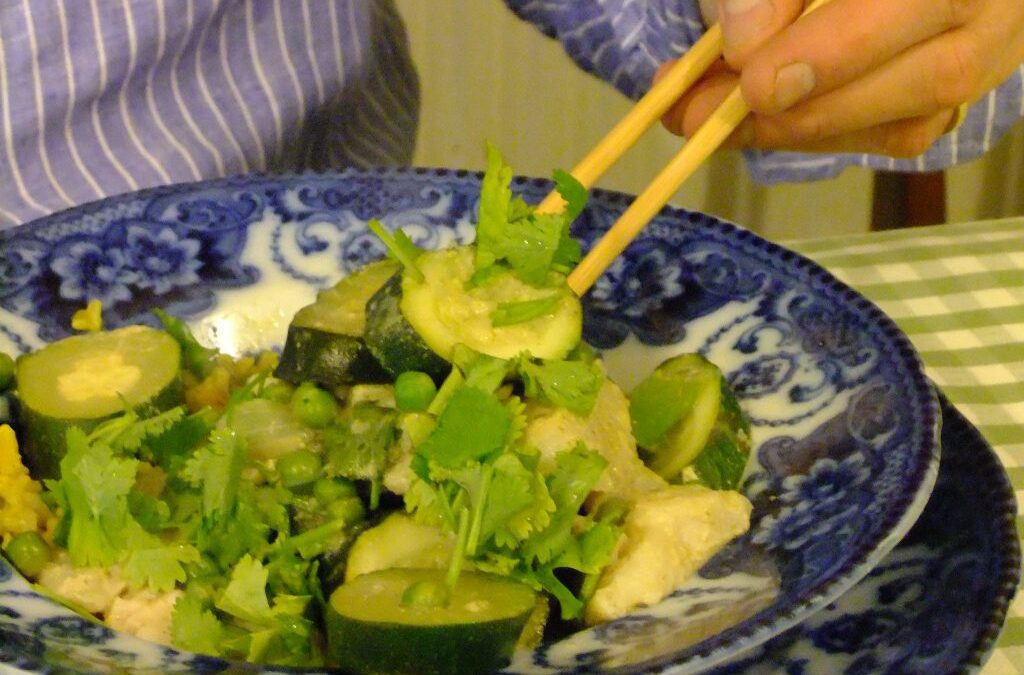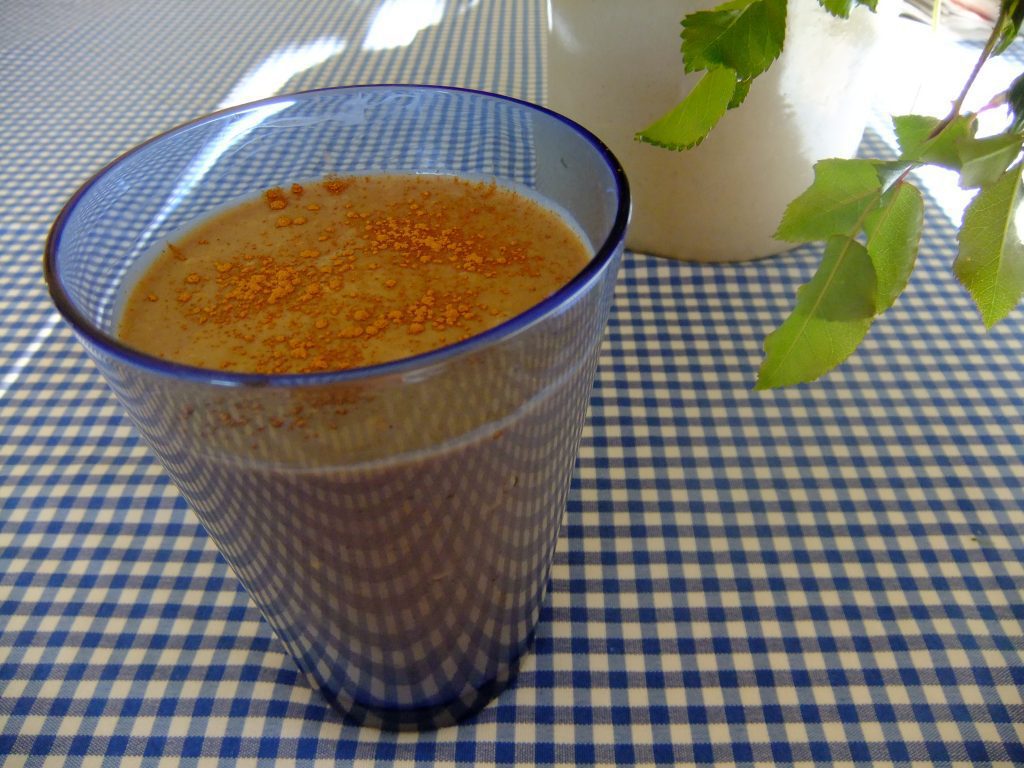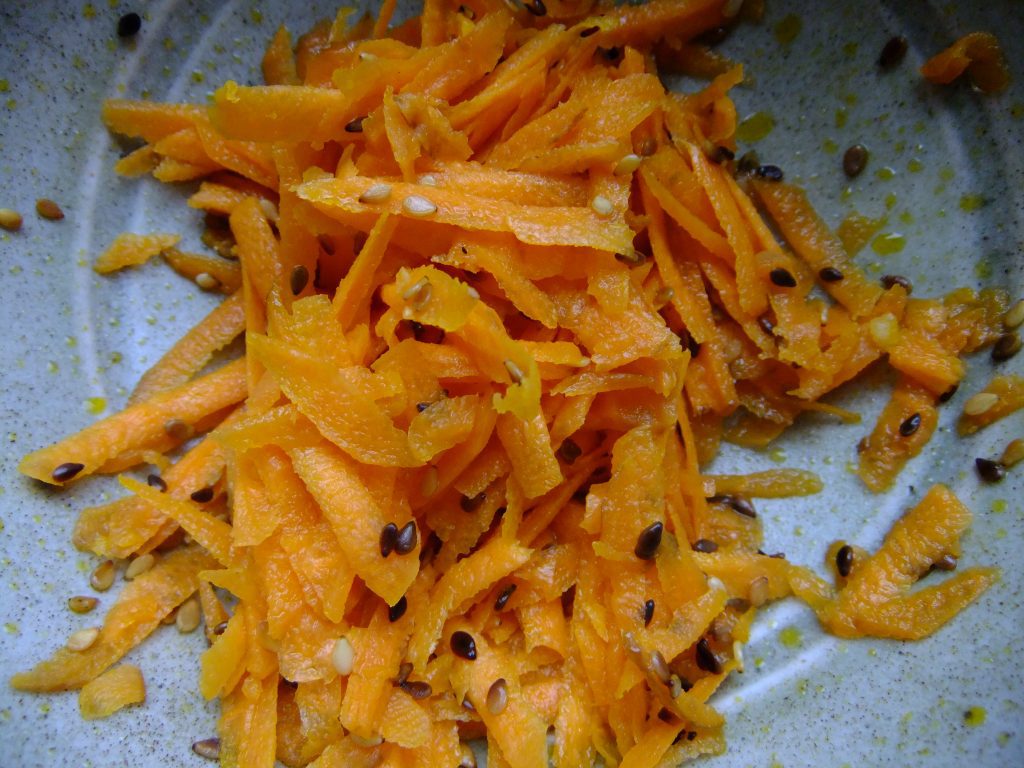
Oct 30, 2015 | Anna's Best Recipes, Sides, starters, soups & snacks
These aren’t fried at all but taste just as delicious. This simple side is good with green veg and some grilled/roasted fish, or roasted meats but it would also be nice with a vegetarian bean stew. You can use pumpkin instead of the squash if you like. I like to add leftovers of this dish to my lunchtime salad the next day.
The recipe is in Raman Prasad’s “Recipes for the Specific Carbohydrate Diet“. As know from my last blog, this diet can be a real lifesaver for people with serious intestinal inflammation (Crohn’s or Colitis). The diet often gets them into a much better state so they can work on the root causes of their condition and move towards staying symptom-free.
For 4-6 servings
1 butternut squash (or small pumpkin)
1 large celeriac
3 tbs (45ml) extra virgin olive oil
Lots of freshly ground black pepper1/2 tsp Himalayan/Atlantic sea salt
One or all of the following if you have them:
1 dsp dried oregano, 1 teaspoon paprika or 2 dsp fresh thyme leaves
1. Preheat (fan) oven to 180C (195 for non-fan).
2. Peel the squash, cut in half, and scoop out the inside seeds. chop into 1.5cm dice. Peel the celeriac and cut into similarly sized cubes.
3. Tip the veg into a large baking tray, sprinkle on the salt, pepper (and herbs/spices if using) and the olive oil. Toss everything well with your hands until everything is well coated.
4. Bake for 30-40 minutes, turning once to ensure they cook evenly.
Why this is good for you:
These veggies are higher in fibre and lower in sugars than potatoes so they are a healthier choice. Orange veg are high in beta carotene, important for skin health and for keeping your digestive system in tip top condition. Unlike potatoes and grains, these are much less likely to irritate an already inflamed digestive system. Because they are starchy carbs (i.e. high in natural sugars) these are not suitable for eating on their own but need protein (e.g. fish, eggs, beans, meat) and green veg alongside for a balanced meal.

Apr 22, 2015 | Anna's Best Recipes, Sides, starters, soups & snacks
If you like both Thai food and Spanish gazpacho you will love this recipe by Domini Kemp. I think it’s fantastic. Have it as a filling snack, as a starter or with some chicken or fish and a little green salad for a main meal. If you don’t like cold soups, then this can be heated very gently until only just lukewarm.
For 4-6 servings
For the soup:
400ml tin full fat coconut milk (go for organic from health shops – free from chemical emulsifiers and BPA in tin linings)
1 large ripe avocado
2 large tomatoes, cut into rough chunks
2 large cloves garlic, peeled and crushed
Big knob ginger
1 large tbs (25g) non-gmo miso paste from a jar or vacuum pack (if you are gluten-free then brown rice miso is best, or hatcho miso)
Juice of 2 limes and 2 lemons
1 courgette, sliced
1 red chilli, de-seeded and sliced
Big bunch each coriander and basil
1 tbsp Thai fish sauce
Black pepper to taste
For garnish:
1 red onion, very finely chopped
Fresh coriander
- Blitz everything except the garnish ingredients in a liquidiser or food processor to form a smooth soup.
- Pour into bowls and sprinkle the finely chopped red onion and coriander on top.
Why this is great for you
The raw miso in this soup is packed with beneficial bacteria so important for your skin, digestion and even your mood. Heating above 45C would destroy these good bacteria so the fact the soup is raw is brilliant. Beneficial bacteria help your body to clear used-up hormones such as testosterone and oestrogens, help repair your intestines and make digestive enzymes and even control your mood and how your skin looks. Coriander, lemon, lime and garlic actively help your liver and gut clear normal (and abnormal) toxins out of your body. In our chemical-laden modern world, this is good news. Coconut milk contains capryllic acid, which, like raw garlic, helps to kill off excessive pathogenic yeasts (eg candida albicans). Fresh coriander also binds to heavy metals (like mercury from dental fillings) and escorts them safely out of your body via your bowel.

Apr 16, 2015 | Anna's Best Recipes, Breakfasts & smoothies
This breakfast is delicious but even more importantly is packed with anti-inflammatory, immune-supporting goodness that keeps you full for hours. It’s fresh and zingy but really filling. If you like your smoothie thinner, add more liquid. If you prefer it thicker add less liquid and eat from the glass with a spoon like I do – yum!
It also has protein which your body needs in order to make antibodies to ward off infections. See below for more details of how this smoothie helps your immune system.
For 1 hungry adult:
1 scoop/2 rounded dsp of Sun Warrior Warrior Blend protein powder or other protein powder of your choice (e.g. pea protein, sprouted rice protein, or for for a dairy option, Solgar Whey to Go Vanilla) If you don’t have protein powder, make sure to use more avocado and seeds to keep you fuller longer
200ml unsweetened milk of your choice: almond, hemp, coconut milk, home-made kefir, milk
1 small/medium pear, washed
2.5cm of peeled sliced fresh ginger (slice it across the grain to avoid long fibres in your brekkie!)
1 level tsp ground turmeric (or half a thumb of peeled fresh turmeric, sliced)
Rounded tbs ground seeds e.g. linseed or a blend (e.g. pumpkin, sesame, sunflower and linseed). If you don’t have seeds you could use nuts, either ground or soaked overnight
Optional: 1/4 ripe avocado (use more if you don’t have protein powder)
Optional: a teaspoon of lecithin granules (helps you digest fats and feeds your brain)
Optional (for extra sweetness): pure stevia drops, erythritol or xylitol to taste, or a little honey
1. Remove stalk from the pear, cut up the rest (seeds and all) and throw in the liquidiser.
2. Add the liquid and then other ingredients. Blitz for a minute until smooth. Enjoy.
Why this smoothie is good for you:
Turmeric, ginger and avocados contain the natural anti-inflammatories curcumin, gingerol and vitamin E. So if you want to get rid of annoying skin conditions or boost your digestive wellness these are fantastic things to add to your everyday eating.
Flax seeds and pears contain soluble fibre which feeds the beneficial bacteria that support your resistance to infections both viral and bacvterial. Ginger is anti-viral too. Ginger and turmeric selectively encourage growth of good bugs in your gut.
Because this breakfast is rich in protein, beneficial oils and low in sugars (from fruit) it helps regulate blood sugar to keep your energy, concentration and mood even throughout the morning. Like all meals, this shouldn’t be gulped down – you need to “chew” all your food to mix it with saliva and digest it properly. Avocados are rich in monounsaturated fatty acids and vitamin E, great for moisturising skin and body from within. Yoghurt and kefir provide friendly bacteria important for a healthy digestion, clear skin and stable mood. Fermenting makes the milk easily digested, removing the casein (dairy protein) that triggers food sensitivities in so many people. Lecithin granules help emulsify (digest) fats and are a great source of phospatidyl choline. Pho. choline is only found in egg yolks, lecithin and organ meats and are essential for memory.

Mar 26, 2015 | Anna's Best Recipes, Sides, starters, soups & snacks
You’ll already know my recipe for creamy cauliflower mash from this blog but I’m discovering even more ways to use this versatile vegetable. My latest discovery is cauliflower “rice”. It’s really simple to make and only takes 5 minutes to cook. We substitute it for rice with our curries and chillies. Yum – and you don’t feel drowsy afterwards. You can rice lots of cauliflower at the same time and store it uncooked in self seal bags/airtight containers in the freezer. To use, simply empty into the steamer (no need to thaw, just break it up with your hands) and steam away. As the title implies, broccoli works just as well for making “rice”. You can even buy frozen broccoli rice in some supermarkets.
There are two methods for cooking this. One using a steamer, one using a pan.
For 4 large servings (steamed version)
1 head cauliflower (about 750g)
Freshly ground black pepper
A pinch of Atlantic sea salt/Himalayan salt
Small knob (level tsp) virgin coconut oil or a splash of extra virgin olive oil
You will also need a food processor and a steamer or pan.
- Break the cauliflower into large florets and discard the large stalks (any more than around 2cm thick).
- In the food processor, pulse until the cauliflower particles are the size of grains of rice.
- Steamer version:
Place in a steamer over boiling water. Steam for 3-4 minutes until softened. Drain well, stir in the oil and pinch of salt.
Frying-pan version (richer, more flavoursome):
Follow steps 1-2 then heat a frying pan or heavy bottomed saucepan on a medium heat.
Add a teaspoon of virgin coconut oil, avocado oil or extra virgin olive oil and a splash of water (around 1 tbs). Cook for 3-4 minutes, stirring often (otherwise it sticks and burns). If its too dry and is catching add a little more water.
Why this is amazing for you:
The advantage of cauliflower over rice is cauliflower doesn’t flood your body with more carbohydrates than you need. Carbohydrates are foods made up mostly of sugars. Potatoes, grains (even wholegrains!), fruit juices, certain fruits and of course sugar and honey are all high carbohydrate foods. Switching to a moderate or low carbohydrate eating style is particularly useful if you want to resolve digestive problems or skin issues. High carbohydrate eating styles make every health condition worse. Reducing your carbohydrate foods can even slow or stop hair loss. A good guideline for a moderate carbohydrate diet is for bread, potatoes, rice or pasta to make up no more than ¼ of your plate at lunch and your evening meal. Cauliflower is not high in carbohydrates so makes a brilliant substitute for the normal potatoes or rice.
Cauliflower contains sulforaphane and indole-3-carbinol, which help reduce excessive oestrogens in your body. Research proves these have activity against prostate, breast and other hormone driven cancers. Di-indolyl-methane (DIM) in cauliflower and broccoli is anti-bacterial, anti viral and helps balance your immune system.

Mar 11, 2015 | Anna's Best Recipes, Breakfasts & smoothies, Main courses
This is a great breakfast (or any meal) and is super fast. The kippers are left to stand in boiling water for a few minutes while you grill the courgettes and tomatoes, simple…
I like to remove the skin of the kipper before cooking because otherwise it causes the fish to curl up unattractively. But if you don’t care about that, don’t bother. You could also have the lovely vegetables more simply with a small smoked mackerel or trout fillet – no need for the pan of water.
1 small kipper (smoked herring) fillet, skin removed with a sharp knife
1 medium courgette, sliced lengthways into strips around ½ cm thick
2 medium tomatoes, halved, woody bit removed
Extra virgin olive oil
1 teaspoons dried oregano
Freshly ground black pepper
1. Boil the kettle. While the kettle is heating up place a small pan on a medium heat to warm before putting in the kipper and pouring on enough boiling water to cover. Take off the heat and leave to poach in the hot water for about 3 minutes.
2. Meanwhile heat the grill. Place the courgettes and tomatoes on a baking sheet or on the grill rack and cook until just softened. You are not looking for everything to be squishy, just heated through and softened slightly.
3. Arrange on a plate, sprinkle with olive oil to taste and scatter the dried oregano over the tomatoes.
4. Serve with the kipper.
Why this is good for you:
Kippers are smoked herrings. Because herrings are a wild cold water fish, they are rich in essential omega 3 fats you need for healthy skin and hair. Omega 3 helps prevent your blood from clotting too much and this helps bring more blood and nutrients to the whole of your body. Oregano, even dried, is high in antioxidants (provided you store it away from light and air) and has anti-fungal, anti-yeast and anti-microbial properties against bad bacteria in your gut. “Bad” bacteria and yeast are a major cause of skin problems and weight issues. They can be lowered, and good bacteria encouraged, by what you eat every day. Tomatoes and courgettes are a rich source of beneficial fibre and (more) antioxidants, which protect our bodies from inflammation and delay the ageing process. This breakfast is very light on carbohydrates (sugars) and free from grains so its super-healthy.

Jan 9, 2015 | Anna's Best Recipes, Sides, starters, soups & snacks
This is a delicious bright green soup and contains protein from the peas. It is a meal in itself and just the thing for a wintery Irish January day while you recover from the festive season splurge. It takes about 20 minutes to make and it freezes well. Dried herbs won’t really cut it in this soup, it just won’t taste great. I got the original recipe from Rose Elliot’s “Gourmet Vegetarian Cooking” but adapted it to use better-for-you oils and fats.
For 4:
15g butter or ghee (clarified butter, suitable for those with dairy intolerance), or if you don’t have either of these, 1 tbs of extra virgin olive oil
1 large onion, chopped
900g frozen peas (petits pois are the nicest)
1½ litre vegetable stock (make by boiling up chopped carrots, onions, cabbage or other green veg stalks, a leek and a bouquet garni) or use Kallo veg stock cubes/Marigold bouillon
A generous handful of fresh thyme sprigs
Freshly ground black pepper
2 tbs chopped fresh mint
To serve: extra virgin olive oil or natural yoghurt
1. Melt the butter in a large sauce pan and add the onion, sweat on a low heat, covered, until soft and translucent.
2. Wash your thyme, then find an elastic band or a piece of string and tie it in a bunch, this saves you spending ages fishing out stray twigs from the soup later. Set aside.
3. Add the peas to the saucepan and cook for 2-3 mins, stirring often. Pour in the stock/water, add the thyme, bring to the boil then cover and simmer for a few mins until the peas are done.
4. Find the bunch of thyme sprigs and roughly (with a spoon) separate the leaves (which you want) from the twigs (which you don’t). Leave the leaves in the soup and throw away the twigs.
5. Add the chopped fresh mint and process till smooth.
Serve with:
A drizzle of extra virgin olive oil (about a teaspoon) or a blob of natural yoghurt on the top. For dairy-free diets, avoid yoghurt.
Variations:
If you want to increase the variety of vegetables in this soup you can add 1 large leek at the same time as the onion.
Why this is good for you:
Peas are a great source of vegetable protein so this is a good sustaining soup and a perfectly balanced meal even on its own. The protein and the fats will keep you full for ages. Like all intensely green vegetables, peas are also rich in magnesium. You need magnesium for stress management, sleep, detox and even weight loss. This soup avoids harmful refined oils (most cooking oils). Refined oils are found in shop confectionery, biscuits and cakes, processed foods and all cooking oils except cold-pressed or extra virgin oils. Heating virgin cold pressed nuts/seed oils makes them harmful. Olive oil can be gently heated, and virgin coconut oil/ghee/butter are safe for cooking at higher temperatures. Marigold, Vecon or Kallo are better quality stock cubes than most. Thyme has powerful antioxidant anti-inflammatory properties which slow ageing and tune up the health of your digestive system. Mint helps calm and soothe your whole digestive system.

Jan 3, 2015 | Anna's Best Recipes, Main courses
We had this for dinner last night – what a lovely change after all the festive overindulgence….
This recipe is great with fillets of lemon sole or monkfish. You could also use cod or hake though these do have a tendancy to break up more easily (so don’t stir during cooking or they will go to mush). Thai Curry paste from Western companies like Sharwoods is less hot then that from Asian shops so choose whatever you prefer. This recipe is also good made with shelled king prawns which can be cooked from frozen (but don’t cook for more than a few minutes or they will become tough!).
For two:
2 medium white fish fillets (about 130-150g each), skinned and cut into bite sized cubes
1 large onion, roughly chopped or a bunch of spring onions, cut in 2cm lengths
200g frozen peas (for alternative, using courgettes, see below)
2 cloves garlic, crushed or chopped
2-3 teaspoons Thai green curry paste (or yellow/red if you don’t have green)
1 small tin coconut milk (165ml tin from Asian shops/good supermarkets)
Juice of 1 small lime (or use the juice of half a lemon)
2-3 heaped tablespoons chopped fresh coriander if you have it
Optional: 1 dsp of Thai fish sauce
1. In a wide bottomed saucepan or frying pan on a medium heat mix the coconut milk, curry paste, and fish sauce if using, and stir until smooth
2. Add the onion and cook, covered, till softened (about 8-10 mins for white onions, about 3 minutes for spring onions).
3. Add the garlic, peas (breaking the lumps up), courgette if using, and fish to the mix in the pan and stir well to coat everything in sauce. If the mixture looks a little less saucy then you would like or looks like drying out, add a tablespoon of water (the fish will give off liquid during the cooking too).
4. Cover with a lid or a plate simmer for about 5 minutes until the fish is opaque.
5. Squeeze over the lime (or lemon) juice, and sprinkle on the coriander.
Serve with:
Low carb or SC Diet: https://annacollins.ie/cauliflower-rice/
OR
Grains (not suitable for SC Diet):
Brown basmati or long-grain rice cooked with ½ teaspoon of turmeric to give a beautiful golden colour.
100% buckwheat noodles (Health stores/Asian shops)
Variation:
We ran out of peas the other night and used a couple of large courgettes instead. Sliced into 1cm disks and added 5 mins after the onions, they are delicious too.
Ketogenic diet option:
Avoid using the peas and instead use courgettes, and don’t use rice or noodles instead. As a cheat, you could use “zero” or “slim” noodles from Asian shops or health stores, which are made from konjac. Konjac helps feed good bacteria in your gut, which can aid weight loss. Konjac is not absorbed or digested by your body, so they effectively have zero calories!!
Why this is good for you:
Herbs, spices (in curry paste) and garlic give a huge boost to your health, helping detoxification, reducing inflammation and delaying ageing (great news for any of us over 30!). If you want beautiful, clear skin and a healthy digestive system, cooking daily with herbs, garlic and spices is a winner. All green vegetables are rich in magnesium, which also helps us to relax, sleep well and feel upbeat. Coconut milk is high in good fats called medium chain triglycerides which are great for energy, being burned off by your body instead of being stored in fat cells. Coconut also contains lauric acid and caprylic acid, both of which help prevent excessive yeasts and “bad” bacteria in your gut. Coriander helps bind (and safely remove) toxins in your digestive system, especially mercury which you ingest (every time you eat) if you have old-fashioned silver-coloured dental fillings. Cooking at low temperatures like this (100C or less), instead of frying or roasting, keeps more nutrients in your food too.

Nov 27, 2014 | Anna's Best Recipes, Cook-in sauces, Main courses, Recipes by category
This is a real crowd-pleaser that an Italian lady taught me to make when I was au-pairing in Rome. Rather then being fried, the meatballs are actually cooked in the tomato sauce. You really need lean meat for this otherwise you’ll have a lot of fat floating on the serface. Its up to you (and incidentally saturated fat is not the demon we were led to believe – much scientific evidence now to prove it).
If you would like to reduce the quantity of meat in the recipe, substitute cooked puy lentils for some of the meat. Raw meatballs freeze well too – just thaw thoroughly before cooking in tomato sauce.
For 5-6 big eaters
For the meatballs:
350g lean beef mince, organic if possible
350g lean lamb mince (or use extra beef mince if you prefer)
2 tbs freshly grated parmesan (if avoiding dairy, use 100% wholemeal gluten-free breadcrumbs instead of the cheese. If you eat gluten, normal brown crumbs are OK)
1 heaped tsp fresh thyme leaves
2 cloves of garlic, crushed
A few good grinds of black pepper
1 organic egg, beaten
A pinch of himalayan or Atlantic sea salt
For the sauce:
1 litre passata (sieved tomatoes)
1 onion, peeled and halved.
1 dsp extra virgin olive oil
Small bunch fresh basil, rinsed, if you have it.
1. In a bowl combine all the meatball ingredients and mix well – the quickest way to do this is with your hands.
2. Shape into balls about ¾” in diameter and place in a single layer on a plate in the fridge to solidify for at least ½ hour if possible.
3. To make the tomato sauce combine the passata, the peeled halved onion and olive oil in a wide-bottomed saucepan or deep frying pan, bring to the boil, then simmer until the onion is translucent – usually about 20 minutes. This sauce can be made up to 2 days in advance if you wish.
4. To cook the meatballs, bring the tomato sauce up to the boil in your wide bottomed saucepan or frying pan, then gently slide the meatballs in so they form a single layer. Do not stir (or you will break up the meatballs), just shake gently if necessary to distribute the meatballs in a single layer.
5. Cook on a medium heat for around 20 minutes until the meatballs are cooked through.
6. Remove the stalks from the basil, tear up roughly and add to the pan. Serve in bowls.
Serve with:
A large salad of green leaves and radicchio, cucumber and thinly sliced red onions
Optional extra (if you don’t want weight loss). Choose one:
A slice of gluten-free wholemeal bread or (if you eat gluten) some 100% wholemeal sourdough bread
2-3 baby boiled potatoes per person
Why this is good for you:
Cooking meat at low temperature in the sauce avoids the production of the harmful oxidation products. Oxidation by products from charring food cause free radical damage, linked to digestive and skin problems, inflammation and premature ageing. Tomato sauce is very rich in lycopene, a potent anti ageing, anti-inflammatory antioxidant. Red meat is a good source of iron so for many people it’s useful to eat once or twice a week.

Jul 16, 2014 | Anna's Best Recipes, Breakfasts & smoothies
This is a gorgeous, thick smoothie and really creamy. It’s my favourite breakfast at the moment. I like to make it so thick I can eat it with a spoon but that’s just me. To thin, add more non-dairy milk. Or more avocado to make it even thicker. The stevia drops are important here because otherwise there will not be the slightest hint of sweetness. I love this smoothie because it fits in well with a paleo way of eating, which makes me feel SO much more energetic. This smoothie will keep you going for hours because the good fats keep you fuller longer.
For 1 big eater
200 ml unsweetened additive-free coconut milk (or use 3 tbs full fat coconut milk from can and top up with water)
1 heaped tsp raw cocoa powder, organic if possible
1 tbs whole flax seeds, soaked overnight in half a cup of water (or use 1 dsp cold-milled flax seeds)
1/2 a ripe avocado
2 dsp protein powder (hemp protein or dairy-based Solgar Whey to Go from health stores or Sun Warrior protein powder which is already sweetened with stevia – you might not need more sweetening)
20 drops pure stevia (a non-toxic sweetener)
1/2 tsp Ceylon cinnamon for sprinkling
Throw everything in the liquidiser and blitz till well smooth. The flax seeds will give you some “bits” and texture. If you don’t like this, use finely ground flaxseeds instead. For an extra health boost and flavour, sprinkle with ground Ceylon cinnamon.
Variations:
For a change from chocolate, use 50g raspberries instead. If you are not on a ketogenic diet, you can add even more raspberries if liked. 50g raspberries contain 2.3g of carbohydrate.
You could use erythritol or xylitol to sweeten (not suitable for a very low carb/ketogenic diet)
Why this is good for you
Avocados are a great source of vitamin E and monounsaturated oils. These help dampen inflammation, keep you fuller longer with their healthy fats, and keep your skin young and smooth. Raw organic cocoa is free of chemical contaminants and like, cinnamon, has powerful antioxidant properties. Antioxidants help keep your digestive system well and reduce inflammation. A bit like long-acting paracetamol but without the dangerous side effects. cinnamon also has antioxidant action and also helps balance blood sugar. This is good news if you are diabetic, pre-diabetic, or struggle with energy peaks and slumps throughout the day. Flax seeds, especially when soaked, emit soluble fibre, a type of mucilage that feeds the beneficial bacteria in your gut. These bacteria manufacture vitamin K (for healthy bones and wrinkle-free skin), and butyric acid which keeps the lining of your bowel healthy and free of tumours. High quality protein is important at breakfast because it keeps you satisfied and helps weight management. Having enough protein helps you be more resilient to stress, maintain muscle mass, and detoxify chemicals, hormones and waste products we make or take in all the time. Did you know that pure cocoa posder is classified as a spice – it’s packed with antioxidants, as is Ceylon cinnamon. If the packet says “cinnamon” then it’s not the useful Ceylon cinnamon, but cassia cinnamon, which does not have the health benefits and in large amounts over a long period of time, can have negative effects.

Jul 8, 2014 | Anna's Best Recipes, Sides, starters, soups & snacks
I was looking for something nice to do with carrots yesterday, found this recipe and adapted it slightly. We didn’t have the coarse-grain mustard or the honey so we left both out and thought it was still nice. I like to make up large bowls of salady things like this in the summer, to keep in the fridge for dipping into at mealtimes. Who wants to spend all evening in the kitchen when the weather’s so nice…
For 2 people (with plenty of leftover dressing):
4 medium carrots
2 tbs sesame seeds
For the dressing:
1 large clove garlic, crushed
Large pinch freshly ground black pepper
1-3 teaspoons of raw honey (optional)
3 heaped dsp coarsegrain mustard (optional) – if you are gluten-intolerant, make sure you check the label!!
400ml virgin cold-pressed sunflower or sesame oil. Dont be temped to use toasted sesame oil, the burnt flavour will be far too strong.
200ml red or white wine vinegar (or you could use apple cider vinegar).
200ml extra virgin olive oil
- First toast the seeds on a dry pan over a medium heat, shaking every so often, until slightly golden. Remove from the heat.
- Put the dressing ingredients in a large screwtop jar and shake well to mix.
- Grate the carrots, add the seeds and enough of the dressing to moisten the whole lot. Stir and serve.
Why this is good for you:
Carrots are a brilliant source of carotenes which help protect your eyesight and also give your skin a golden glow, making you look more suntanned. They also help your skin protect itself against UV rays, like a sort of edible sunblock. Raw, unheated (virgin) sesame and sunflower oil are high in omega 6, which helps balance your hormones for increased energy, better mood and even smoother, more moisturised skin. It’s even helpful in reducing PMS. Extra virgin olive oil, while not high in omega 6, is packed full of vitamin E which moisturises your skin from within. Vitamin E helps your body conserve and reuse the vitamin C you get in your diet – increasing its benefitial effects. Vitamin E from olive oil also has an anti-allergy effect. This means it can help reduce symptoms of hayfever, asthma and skin allergies. Mustard is a spice andlike most spices has antioxidant properties linked to slowing ageing, soothing inflammatory conditions and balancing your immune system.

